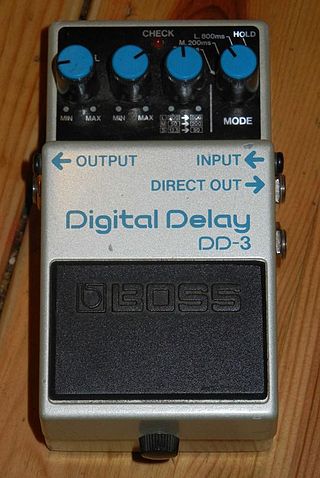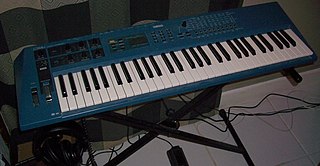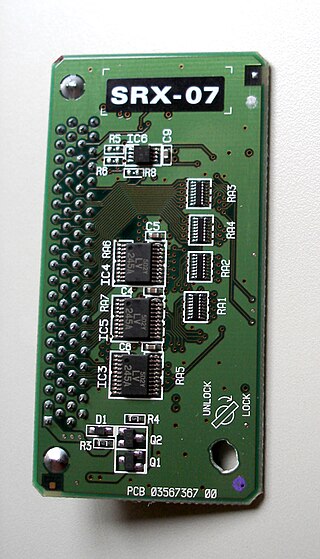Related Research Articles

The Korg M1 is a synthesizer and music workstation manufactured by Korg from 1988 to 1995. It is one of the bestselling synthesizers in history, selling an estimated 250,000 units. The M1 was widely used in popular music and stock music in the late 1980s and early 1990s. The piano and organ presets were used in 1990s house music, beginning with Madonna's 1990 single "Vogue".

The Roland D-50 is a synthesizer produced by Roland and released in April of 1987. Its features include digital sample-based subtractive synthesis, on-board effects, a joystick for data manipulation, and an analog synthesis-styled layout design. The external Roland PG-1000 (1987) programmer could also be attached to the D-50 for more complex manipulation of its sounds. It was also produced in a rack-mount variant design, the D-550, with almost 450 user-adjustable parameters.

The Roland MC-303 is the first of a series of musical instruments known as a groovebox. It combines a simple sound module with a sequencer to record and store notation, along with controls aimed at encouraging the musician to improvise the music while it is playing. Despite the number in its name and the attention it received at its launch, the MC-303 has more in common with other MC prefixed synthesizers, which contain built-in sequencers, than it does with the famous Roland TB-303. As the first Groovebox, the MC-303 was the first in a line of inexpensive products specifically targeted towards house DJs and amateur home musicians rather than professional producers. It was superseded by the Roland MC-505. It is the predecessor to the Roland JX-305, Roland D2, Roland MC-307, Roland EG-101, Roland MC-09, Roland MC-909, Roland MC-808, and most recently the Roland MC-707 in 2019, along with its more portable sibling, the Roland MC-101.
A rompler is an electronic musical instrument that plays pre-fabricated sounds based on audio samples. The term rompler is a blend of the terms ROM and sampler. In contrast to samplers, romplers do not record audio. Both may have additional sound editing features, such as layering several waveforms and modulation with ADSR envelopes, filters and LFOs.

The Roland MT-32 Multi-Timbre Sound Module is a MIDI synthesizer module first released in 1987 by Roland Corporation. It was originally marketed to amateur musicians as a budget external synthesizer with an original list price of $695. However, it became more famous along with its compatible modules as an early de facto standard in computer music. Since it was made prior to the release of the General MIDI standard, it uses its own proprietary format for MIDI file playback.
Roland GS, or just GS, sometimes expanded as General Standard or General Sound, is a MIDI specification. It requires that all GS-compatible equipment must meet a certain set of features and it documents interpretations of some MIDI commands and bytes sequences, thus defining instrument tones, controllers for sound effects, etc.

Delay is an audio signal processing technique that records an input signal to a storage medium and then plays it back after a period of time. When the delayed playback is mixed with the live audio, it creates an echo-like effect, whereby the original audio is heard followed by the delayed audio. The delayed signal may be played back multiple times, or fed back into the recording, to create the sound of a repeating, decaying echo.
Linear arithmetic synthesis, or LAsynthesis, is a means of sound synthesis invented by the Roland Corporation when they released their D-50 synthesizer in 1987.

The Yamaha CS1x is a sample-based synthesizer released by the Yamaha Corporation in 1996.

The Roland U-20 is a PCM-sample synthesizer, released by Roland in 1989.It was the keyboard version of the U-220 rack module, which was in turn a similar follow-up product to Roland's U-110 rack module of 1988.

The SRX are a series of expansion boards produced by Roland Corporation. First introduced in 2000, they are small boards of electronic circuitry with 64MB ROMs containing patches (timbres) and rhythm sets. They are used to expand certain models of Roland synthesizers, music workstations, keyboards, and sound modules.
The Yamaha V50 is a hybrid music workstation introduced in 1989. It combines a sequencer, rhythm machine, an FM synthesis-based sound module and a MIDI keyboard.

The Roland XP-50 is a music workstation that combines the synthesizer engine of Roland's JV-1080 sound module with the sequencing capabilities of their MRC-Pro sequencer and a 61-note keyboard. First released in 1995, the XP-50 and the Roland XP-10 were the first two Roland XP-series products, later joined by the XP-80 and XP-30.
The Roland JD-990 Super JD is an updated version of a Roland JD-800 synthesizer in a form of a module with expanded capabilities, which was released in 1993 by Roland Corporation. JD-990 is a multitimbral synthesizer utilising PCM sample-based synthesis technology. In a sense it is not a true module version of a JD-800 as it has many expanded features and as a result the two are incompatible in exchanging presets. It is equipped with 6 MB of ROM containing sampled PCM waveforms, four sets of stereo outputs that are assignable to individual, internal, instruments, and standard MIDI in/out/through ports. JD-990 has a large LCD display and programming takes place through a keypad on the front panel of the unit. The unit can generate multi-timbral sounds reminiscent of the vintage analogue synthesizers but is also capable of generation of modern digital textures. There are several expansion boards available for JD-990 that can be installed in the provided expansion slot in the chassis of the unit.

The Roland JV-1080 is a sample-based synthesizer/sound module in the form of a 2U rack. The JV-1080's synthesizer engine was also used in Roland's XP-50 workstation (1995). Due to its library of high-quality sounds and multi-timbral capabilities, it became a mainstay with film composers.
The Roland D2 Groovebox is a performance-oriented Groovebox. It has Roland's D-Field Controller technology. It has all of the Roland MC-505 sounds and a similar sequencer. All of the MFX effects have sub-menus. The D2 has 100+ sub-menus to sub-sub-sub-menus, and this is why it has fewer buttons than other Grooveboxes.
The Roland ED SC-8850 is a GS-compatible MIDI sound module released in 1999 by Roland under the name RolandED. The SC-8850 was the first sound module to incorporate the new General MIDI Level 2 standard. The SC-8850 uses a PCM sampling engine based on that of the SC-88 Pro, and supports 128-voice polyphony with 64-part multitimbrality. It came preloaded with the soundsets of all older Sound Canvas models, as well as the CM-32 and MT-32. Aimed at personal computer users, the SC-8850 features 1,703 instrument patches, including the GS sounds and additional GM2 sounds. The selection of effects includes reverb, chorus, and Roland's own Insertion EFX, which adds effects like vibrato, distortion, tremolo, etc.
The Roland GR-1 is a guitar synthesizer that was manufactured by Roland Corporation. It was introduced in 1992.
The Kawai K1 is a 61 key synthesizer manufactured in 1988 by Kawai. It is an entry-level and low fidelity synthesizer and not as feature rich as the Kawai K4 and was released to compete with the Roland D50 and Korg M1 synthesizers. The patch memory can be doubled with a DC-8 memory card which was available separately.
References
- ↑ "d-70". www.synthmania.com. Retrieved 2018-06-11.
- ↑ "Roland D70 (MT Aug 90)". www.muzines.co.uk. Retrieved 2018-09-03.
- ↑ "Roland D-70 | Vintage Synth Explorer". www.vintagesynth.com. Retrieved 2018-06-11.
- ↑ "Roland D-70 Super LA Synthesizer". Encyclotronic. Retrieved 2018-09-03.
- ↑ "Roland D-70 Technical Specifications | Sweetwater". SweetCare. Retrieved 2018-06-11.
- ↑ "Roland D-70". www.retrosynth.com. Retrieved 2018-09-03.
- ↑ "Roland D-70". www.retrosynth.com. Retrieved 2018-09-03.
- ↑ "Roland D70 (MT Aug 90)". www.muzines.co.uk. Retrieved 2018-09-03.
- ↑ "Roland D70 (MT Aug 90)". www.muzines.co.uk. Retrieved 2018-06-12.